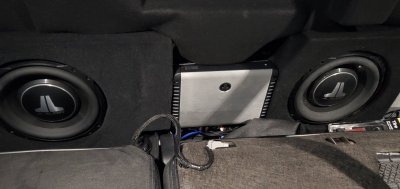My thoughts on DSP are this......I have been doing high end car audio and home theater since the late 1980's. Longer then some people have been alive (sadly).
In a car environment...it is absolutely correct that speaker placement is not ideal. woofers and tweeters many times are off axis from each other causing frequencies to arrive at your ear unequal times. So an electronic DSP can help here. But what also helps is understanding how frequencies work. The lower the frequency, the less it is impacted by frequency localization (where you can pin point its direction). It is why you can stick a sub in the corner of a room and no one know where it is.
The critical component in time and spacial alignment becomes more apparent on mid to high frequencies. In the front of a car, this is accounted for by where the tweeters are placed, high on the A pillars. Note, in our trucks, they are fired in the direction of the windshield. This helps improve the front sound stage (dash is the stage) and imparts a natural time delay for those frequencies (which move faster then mids and lows) and allows them to hit your ears in alignment with the door woofers.
Yes, the driver is sitting stage left....but in a concert hall if you are sitting in the left orchestra box, are they going to give you headphones with a fancy DSP to make your seat electronically become center stage? No. Part of the beauty of music and a well produced sound stage is some sounds are more localized left or right.
In a car you have balance and fade, speaker gain, treble, mid, and high control, and the EQ built into your iphone or spotify account. There is plenty of adjustabillity for one to dial in the sound for that vehicle. This is on top of correctly installed speakers.
In a home environment most rooms are very boxy at 10-20x larger then the space in a car, with harsh surfaces on floors and big walls that bounce sound all over the place. A DSP can correct many of these issues. Time alignment is more critical when you are 15 feet from your tweeter, not 3 feet.
But in a home, you can correct many of these issues with proper speaker placement, wall treatments, and other soft materials.
My home theater at home is state of the art Denon Dolby Atmos in a 7.4.2 configuration (7 surrounds, 4 ceiling, 2 subs). I have it dialed in with Denon's Audyssey DSP. But 90% of the time, I go direct (no dsp) because it sounds better to me without the electronic compensation. My room is prepped to care for many of the things DSP was created to correct. i want to hear my speakers reproduce what was recorded, not some lab technicians algorithm.
The point of all this rant is.......There is no magic electronic gizmo that will make a stereo sound good. nothing is more important then proper system design, and installation. yes, DSP has its place and benefits. But to discount a non DSP system as trash, or someone who does not use one as ignorant is just false, and shows who the real amateurs are.


